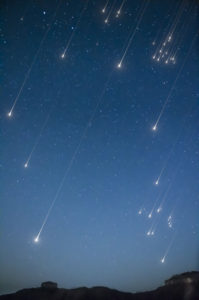Get set for a thrilling sight in the early morning skies––the Perseids meteor shower.
Get set for a thrilling sight in the early morning skies––the Perseids meteor shower.
By Steve Kates
The heat of summer continues. With no end to triple-digit temperatures in sight, the only reprieve we can expect is in the form of monsoon showers. While there’s no guarantee of a monsoon, we’re in store for a far more reliable type of shower––the Perseids meteor shower.
The Perseids are one of the great meteor showers of the entire year and we await its peak on the night of Aug. 11. It should be quite a good show. The Perseids are a very reliable shower and the source of its meteors is an old comet; 109P/Swift–Tuttle.
This is a good year for viewing the Perseids, as the moon will set near 1 a.m., providing us with a great dark sky viewing of the shower as it peaks just before dawn on Aug.12.
Observers under dark and monsoon-free skies can expect to see some 80 to 100 meteors per hour.
Recent observations and calculations indicate that Jupiter may have moved a larger portion of this comet debris closer to Earth and that the 2016 Perseids may be even stronger. We will have to wait and see. To get the best view of this amazing shower, look to the northeastern sky around midnight and follow the rising radiant in the northeastern sky all night.
We’ll be having our second Meteor Madness event at the Lost Dutchman State Park on Fri., Aug. 12 at 8 p.m. It’s a great social event for people who want to experience the best of this great sky sighting. To learn more, get your tickets at meteormadness2016.eventbrite.com.
Now on to the moon, which appears at its new phase on Aug. 2. This is a great time to view the summer Milky Way in the southern sky at sunset. The moon passes close to Jupiter on the night of the 5th and the planet Mars on the 11th. First quarter moon occurs on the 10th, with the Full Sturgeon Moon on the 18th at 2:27 a.m. (MST). Last quarter moon is on the 24th.
August is rich in planets too. Look low in the northwest at sunset to see Jupiter. Jupiter and Venus have a great close conjunction on the night of Aug. 27 that is only 0.07 degrees apart. Meanwhile, Mars is high in the southwestern skies at sunset, with Saturn just a few degrees to the left.
September offers us additional sky treats, as the summer heat finally brakes. The month also heralds the end of the monsoon and a return to cooler weather. The moon graces our September skies, as it reaches its new phase on the 1st and then rapidly moves on to first quarter on the 9th.
Get set for another spectacular full moon on the 16th. This is the annual Harvest Moon as it reaches its full phase at 12:05 p.m. (MST) The Harvest Moon is the full moon that is closest to the Autumnal Equinox. The Autumnal Equinox occurs on the 22nd near 8 a.m. local time.
The Harvest Moon rises just after sunset at this time of year and rises at nearly the same time for the next few nights. It appears to light up the sky.
September is filled with planet sightings too. Venus returns to the evening sky and is easy to view, low in the western sky at sunset. Jupiter reaches conjunction on the 26th, with Mars bright and low in the southwest at sunset. Saturn is also visible low in the southern skies at sunset. Mercury is best seen low in the morning sky, by the 28th, some 18 degrees ahead of the sun, in the eastern sky.
Finally, from the world of space, the Juno spacecraft, launched back in 2011, arrived at Jupiter in July. It’s an interesting spacecraft, whose mission is to map the magnetic field of Jupiter and look at its solid core. So, as you look at Jupiter, low in the northwest at the end of August, know that Juno is searching for answers about this giant planet.
Perseid Meteors
- The average size of a Perseid meteor is about the size of a sand grain.
- The parent comet of the Perseids, 109P/Swift Tuttle, has been described as
- “The single most dangerous object known to humanity,” as it can get very close to
- Earth. Lucky for us, there is no real chance of a collision in the next few hundred years.
Harvest Moon
- The full moon that occurs closest to the Autumnal Equinox.
- The Nov. 2016 full moon will be the closest full moon of the year at only 221,524 miles away.
Related posts
Leave a Comment
You must be logged in to post a comment.







